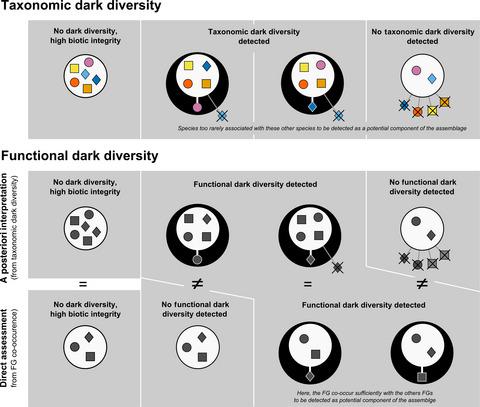当前位置:
X-MOL 学术
›
J. Appl. Ecol.
›
论文详情
Our official English website, www.x-mol.net, welcomes your feedback! (Note: you will need to create a separate account there.)
From taxonomic to functional dark diversity: Exploring the causes of potential biodiversity and its implications for conservation
Journal of Applied Ecology ( IF 5.7 ) Pub Date : 2021-09-21 , DOI: 10.1111/1365-2664.14033 Loïs Morel 1 , Vincent Jung 2 , Simon Chollet 2 , Frédéric Ysnel 1 , Lou Barbe 2
中文翻译:

从分类到功能性暗多样性:探索潜在生物多样性的原因及其对保护的影响
更新日期:2021-09-21
Journal of Applied Ecology ( IF 5.7 ) Pub Date : 2021-09-21 , DOI: 10.1111/1365-2664.14033 Loïs Morel 1 , Vincent Jung 2 , Simon Chollet 2 , Frédéric Ysnel 1 , Lou Barbe 2
Affiliation

|
- The conservation of natural habitats requires an accurate assessment of both their degradation and their potential for restoration. Among the tools available, dark diversity is promising, since it estimates all the species that could be present in a community due to favourable environmental conditions but are currently lacking. However, current experimental approaches measure dark diversity mainly from species co-occurrences, which rely partly on neutral processes, and also suffer from several problems concerning the inclusion of rare species.
- Here, we propose a novel method to estimate dark diversity, which is based on more deterministic co-occurrence and also strongly limits the problems of rarity: the co-occurrence of species' functional features. We adapted the Beals' co-occurrence index using functional groups, and we estimated functional dark diversity based on co-occurrence of functional groups. To illustrate the interests of our approach, we then addressed as an example a major issue of restoration ecology: how does passive rewilding (i.e. spontaneous restoration of woodlands) impact the ecological integrity of recovered communities? We compared post-agricultural woodlands with ancient forests, in terms of taxonomic and functional dark diversity of vascular plants and spiders.
- For both taxa, the patterns of dark diversity in recent woodlands and ancient forests changed depending on whether we used the taxonomic or functional approach. This was due to the detection of functional features even if they were hosted by rare species, and to the consideration of ecological redundancy between species in functional groups. Notably, recent woodlands harboured plant communities with a similar amount of taxonomic dark diversity compared to ancient forests, but with less functional dark diversity. Also, the composition of functional dark diversity clearly differed between forest types.
- Synthesis and applications. Functional dark diversity brings novel perspectives for ecological diagnostic and restoration. In particular, it provides a more mechanistic understanding of the constraints which limit the re-assembly of natural communities during restoration practices (e.g. dispersal limitation). The functional approach usefully complements the taxonomical one to identify habitat conservation and restoration interests, especially for highly degraded sites where the detection of missing groups via species is biased because of their rarity.
中文翻译:

从分类到功能性暗多样性:探索潜在生物多样性的原因及其对保护的影响
- 自然栖息地的保护需要对其退化及其恢复潜力进行准确评估。在可用的工具中,暗多样性是有希望的,因为它估计了由于有利的环境条件而可能存在于一个社区中但目前缺乏的所有物种。然而,目前的实验方法主要从物种共现来测量暗多样性,这部分依赖于中性过程,并且还存在与稀有物种包括相关的几个问题。
- 在这里,我们提出了一种估计暗多样性的新方法,该方法基于更具确定性的共现,同时也强烈限制了稀有性问题:物种功能特征的共现。我们使用功能组调整 Beals 的共现指数,并根据功能组的共现估计功能暗多样性。为了说明我们的方法的利益,我们以恢复生态学的一个主要问题为例:被动野化(即林地的自发恢复)如何影响恢复社区的生态完整性?我们在维管植物和蜘蛛的分类和功能暗多样性方面将后农业林地与古代森林进行了比较。
- 对于这两种分类群,近代林地和古老森林中的暗多样性模式会根据我们使用分类学方法还是功能方法而发生变化。这是由于即使它们是由稀有物种寄宿的功能特征的检测,以及功能组中物种之间的生态冗余的考虑。值得注意的是,与古代森林相比,最近的林地中的植物群落具有相似的分类暗多样性,但功能性暗多样性较少。此外,功能性暗多样性的组成在森林类型之间明显不同。
- 合成与应用。功能性暗多样性为生态诊断和恢复带来了新的视角。特别是,它提供了对在恢复实践中限制自然群落重新组装的约束的更机械的理解(例如分散限制)。功能方法有效地补充了分类方法,以确定栖息地保护和恢复利益,特别是对于高度退化的地点,在这些地点通过物种检测缺失的群体由于其稀有性而存在偏差。



























 京公网安备 11010802027423号
京公网安备 11010802027423号